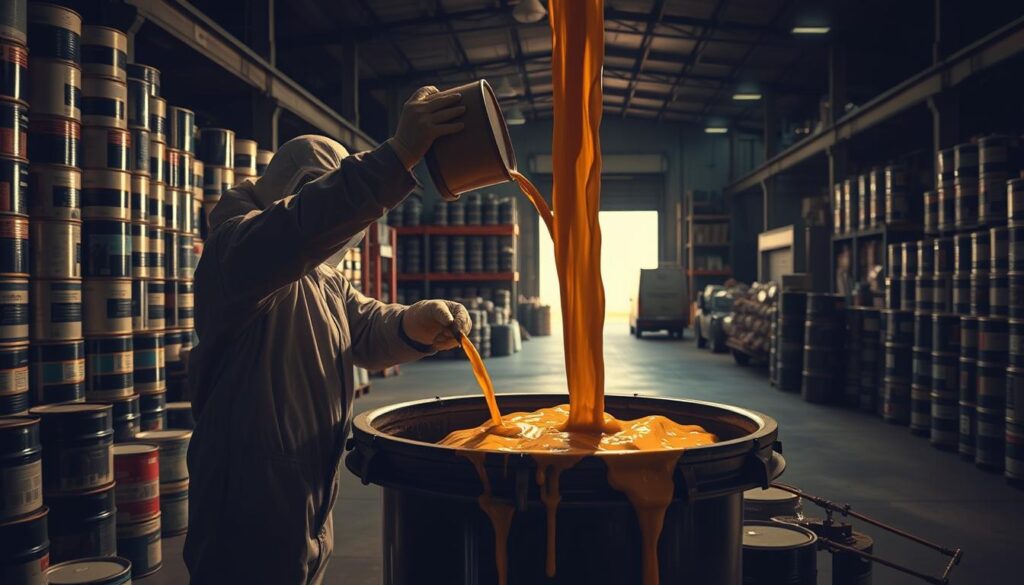Are you unsure about how to safely get rid of leftover paint in your home or garden? The improper disposal of paint can have severe environmental and health consequences.
Different types of paint require distinct disposal methods due to their varying compositions. In the UK, it’s crucial to handle paint waste carefully to prevent water contamination, soil pollution, and potential health hazards.
This comprehensive guide will walk you through understanding the different types of paint and their disposal requirements, finding local disposal resources, and exploring recycling options available to UK residents.
Key Takeaways
- Understand the different types of paint and their environmental impacts.
- Learn the proper disposal methods for various paint types.
- Discover local resources for paint disposal and recycling in the UK.
- Comply with UK regulations regarding hazardous waste management.
- Protect the environment and public health through responsible paint disposal.
Understanding Different Types of Paint
Different types of paint require different disposal methods, making it essential to know what you’re handling. Understanding the composition of your paint is crucial for its safe and environmentally friendly disposal.
Characteristics of Oil-Based Paint
Oil-based paint, also known as solvent-based paint, contains pigments suspended in a drying oil or alkyd resin. This type of paint is known for its durability and glossy finish but is more challenging to clean up and has higher VOC levels.
Features of Water-Based Paint
Water-based paint, or latex paint, uses water as its solvent. It’s easier to clean up and has lower VOC levels compared to oil-based paints. This makes it a popular choice for interior projects.
Latex-Based Paint Specifics
Latex-based paint is a specific type of water-based paint that contains synthetic polymers like acrylics. It’s popular for both interior and exterior applications due to its durability and ease of use. Latex paints are generally considered more eco-friendly than oil-based alternatives but still require proper disposal. They have lower VOC levels, are easier to clean up, and dry quickly, making them ideal for DIY projects. Notably, modern latex paints don’t contain natural latex rubber, reducing the risk of allergic reactions.
Why Proper Paint Disposal Matters
You might not think twice about disposing of old paint, but doing so responsibly is vital for preventing harm to the environment and your community. Proper disposal of paint is crucial because it contains chemicals that can be classified as hazardous waste if not handled correctly.
The environmental and health impacts of improper paint disposal are significant concerns that warrant careful consideration.
Environmental Impact
Improper disposal of paint can lead to environmental contamination. When paint is poured down drains or thrown into regular bins, it can end up in waterways and soil, causing harm to wildlife and ecosystems.
| Environmental Risk | Consequence of Improper Paint Disposal |
|---|---|
| Water Pollution | Paint chemicals can contaminate rivers and lakes, affecting aquatic life. |
| Soil Contamination | Paint can seep into the ground, potentially affecting plant growth and soil quality. |
Health Hazards
Improper paint disposal poses several health risks. Volatile Organic Compounds (VOCs) from paint can cause respiratory issues. Older paints may contain lead or other heavy metals, which are particularly hazardous.
- Respiratory problems due to VOC exposure
- Risk of paint chemicals entering the food chain through contaminated water and soil
- Specific health concerns related to lead or heavy metals in older paints
- Occupational hazards for waste management workers
- Vulnerability of children and pets to paint toxins

Common Mistakes When Disposing of Paint
Disposing of paint might seem straightforward, but there are several common pitfalls to avoid. When you’re looking to get rid of old paint, it’s crucial to do so in a manner that is both safe and compliant with UK regulations.
Pouring Paint Down Drains
One of the most harmful methods of paint disposal is pouring it down the drain. This can lead to significant environmental issues, as paint can contaminate waterways and harm aquatic life. Moreover, many local councils have strict regulations against disposing of hazardous waste, including paint, through drainage systems.
Throwing Paint in Regular Bins
Disposing of liquid paint in your regular household waste bin is another common mistake. Liquid paint can leak from the bin during collection, contaminating other recyclables and posing hazards to waste workers. In the UK, liquid paint is banned from landfills, making this method non-compliant with regulations. Furthermore, paint cans containing liquid paint can damage waste collection vehicles and processing equipment, leading to costly repairs.
Council waste collectors may refuse to collect bins that contain liquid paint, leaving you to deal with the issue. This seemingly convenient disposal method can actually be harmful and potentially costly. It’s essential to explore alternative, responsible disposal methods.
How to Dispose of Oil-Based Paint Responsibly
You must take specific steps to dispose of oil-based paint in an environmentally responsible manner. Oil-based paint contains hazardous chemicals that can harm the environment if not disposed of correctly.
Finding Hazardous Waste Collection Sites
To dispose of oil-based paint, you need to find a hazardous waste collection site. These sites are specifically designed to handle hazardous materials, including oil-based paint. You can search online or contact your local council to find a collection site near you.
Preparing Oil-Based Paint for Disposal
Before taking your oil-based paint to a collection site, you need to prepare it properly. Keep the paint in its original container with the label intact. For small amounts, you can harden the paint using absorbent materials like cat litter or sawdust. Ensure the container is tightly sealed to prevent leaks during transport. It’s also crucial to work in a well-ventilated area to avoid inhaling fumes.
| Preparation Step | Description |
|---|---|
| Keep in original container | Ensure the paint is in its original container with the label intact for proper identification. |
| Harden small amounts | Use absorbent materials like cat litter or sawdust to harden small amounts of leftover paint. |
| Seal containers tightly | Properly seal paint containers to prevent leaks during transport. |
| Work in a well-ventilated area | Ensure good ventilation when handling oil-based paint and its disposal materials. |
How to Dispose of Water-Based Paint Responsibly
You can dispose of water-based paint responsibly by following a few simple steps. Water-based paint, while more environmentally friendly than oil-based paint, still requires careful disposal to prevent harm to the environment.
Drying Out Water-Based Paint
To dispose of water-based paint, you first need to dry it out completely. This can be done by leaving the lid off the paint can and letting it sit until the paint has solidified. You can also mix the paint with absorbent materials like cat litter or sawdust to speed up the drying process.
It’s essential to check that the paint is completely dry before disposal. Ensure there’s no liquid remaining and that the paint has reached a solid consistency.
Disposing of Dried Water-Based Paint
Once the paint is dry, you can dispose of it through your regular household waste collection. To prepare the paint can for disposal, remove the lid to show waste collectors that the paint is dry. It’s also worth noting that acceptance policies for dried paint can vary locally, so it’s a good idea to check with your local waste collection service.
- Check if your local household waste collection service accepts dried water-based paint.
- If not, consider alternative disposal options such as local recycling centers.
- Empty metal paint cans can often be recycled after the paint has dried completely.
Proper disposal of water-based paint is crucial for environmental protection. By following these steps, you can ensure you’re disposing of water-based paint in a responsible manner.
Recycling and Donating Unused Paint
Reducing waste by recycling and donating unused paint is a simple yet effective way to contribute to a more sustainable environment. You can explore various options to give your leftover paint a new life.
Community RePaint Schemes
Community RePaint schemes are a fantastic way to recycle leftover paint. These schemes, available across the UK, collect and redistribute paint to those who need it, such as community groups and individuals undertaking DIY projects. By donating your unused paint, you’re supporting local initiatives and reducing waste.
Other Donation Options
Beyond Community RePaint schemes, there are other organisations you can donate to, including local schools, community centres, theatre groups, and charitable organisations. You can also use online platforms and local community groups to offer your paint to those who might need it. Ensure the paint is in good condition and properly labelled before donating.
Disposing of Empty Paint Containers
Disposing of empty paint containers requires careful consideration to minimize environmental impact. You can recycle or dispose of them in an environmentally friendly manner, but the process varies depending on the material.
Metal Paint Tins
Metal paint tins are generally recyclable. To recycle them, ensure they are empty and dry. You can check with your local waste authorities to see if they accept metal paint tins in their recycling programs. Some councils may have specific collection days for metal waste.
Plastic Paint Containers
Plastic paint containers have different recycling options. You need to identify the type of plastic used and check if it’s recyclable in your area. Some plastics are not accepted in standard recycling programs, so it’s essential to check with your local waste authorities. Cleaning the containers before recycling is also crucial.
| Container Type | Recyclable | Cleaning Required |
|---|---|---|
| Metal | Yes | Yes, ensure dry |
| Plastic | Depends on type | Yes, thorough cleaning |
For both metal and plastic containers, it’s essential to check with your local waste authorities for specific guidelines. Some may have special collection events or facilities for handling hazardous waste, including containers that held oil-based paint.

Local Resources for Paint Disposal in the UK
If you’re wondering how to get rid of old paint, the UK has several local resources at your disposal. You can utilise various facilities and services provided by local councils and recycling centres.
Household Waste Recycling Centres
Many UK towns and cities have Household Waste Recycling Centres where you can take your old paint for disposal. These centres are equipped to handle hazardous waste, including paint.
Council Collection Services
Some councils offer special collection services for hazardous waste like old paint. You can contact your local council to arrange for a collection, though there may be specific preparation requirements and potential costs involved. Not all councils provide this service, so it’s essential to check beforehand.
Conclusion
In conclusion, the responsible disposal of old paint is vital for maintaining a healthy environment. Throughout this guide, we’ve explored the different types of paint and their respective disposal methods, emphasizing the importance of proper disposal for environmental protection and public health.
By taking the time to dispose of paint properly, you’re not only protecting the environment but also contributing to a safer community. For more information on paint disposal, visit our resource page. By sharing this knowledge, you can promote wider responsible disposal practices and make a significant difference.



